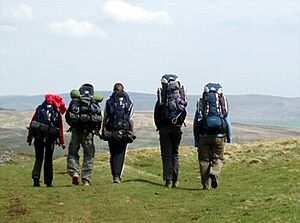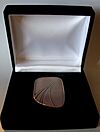The Duke of Edinburgh's Award facts for kids
Quick facts for kids The Duke of Edinburgh's Award |
|
|---|---|
 |
|
| Date | 13 October 1956 |
| Country | Commonwealth (including the United Kingdom, Canada, Australia, and New Zealand) |
| Reward | Bronze, Silver, or Gold |
| Currently held by | Prince Edward, Duke of Edinburgh |
The Duke of Edinburgh's Award, often called DofE, is a special program for young people. It was started in the United Kingdom in 1956 by Prince Philip, Duke of Edinburgh. This award program helps young people and teenagers improve themselves. It has grown a lot and is now available in 144 countries around the world.
History of the Award
The Duke of Edinburgh's Award was first announced in February 1955. It was originally for boys aged 15 to 18. John Hunt, who led the first successful climb of Mount Everest in 1953, helped create and manage the program.
The award was made to attract boys who were not part of other youth groups like the the Scout Association. In its first year, 7,000 boys joined. The program took ideas from other awards, like the Moray Badge.
In November 1957, it was announced that girls could also join. The program was opened to girls on June 19, 1958. The girls' program was for ages 14 to 20. The first girls received their Gold Awards in November 1959 at Buckingham Palace.
The first Gold Awards were given out in 1958. The charity that runs the award was set up in 1959. In 1969, a single program was created for young people aged 14 to 21. This was later extended to include those up to 25 years old in 1980.
The Award in the United Kingdom
The first Duke of Edinburgh's Award ceremony was held in the United Kingdom in 1956. More and more young people have joined the DofE program every year since it started. Young people take part in DofE programs at special centers. These centers include schools, youth clubs, and cadet groups.
Over 6 million people have taken part in the DofE in the UK since 1956. Worldwide, more than 8 million people have participated. In 2009, a new online system called eDofE was launched. This system helps participants track their progress. Leaders also use it to check on how everyone is doing.
Award Programmes Explained
Duke of Edinburgh's Award programs usually take between one and four years to finish. Participants must complete their award by their 25th birthday. There are three levels: Bronze, Silver, and Gold. Each level is more challenging than the last.
With help from adult leaders, participants choose activities and set goals in five different areas:
- Volunteering: This means helping other people or your community.
- Physical: This involves improving in a sport, dance, or other fitness activity.
- Skills: This is about learning new practical or social skills, or developing a personal interest.
- Expedition: This is an adventurous journey that you plan, train for, and complete. It can be in your own country or abroad.
- Residential (Gold level only): For the Gold Award, you must also do a Residential section. This means staying and working away from home for five days. You will do a shared activity with new people.
To earn an award, you must work on each section for a certain amount of time. Someone who knows about your chosen activities will monitor and assess your progress. Each level needs more time and effort:
- Bronze: 3–6 months
- Silver: 6–9 months
- Gold: 12–18 months
Participants need to show regular activity and commitment. This usually means spending at least one hour per week on their DofE program.
Joint Award Initiative
In Northern Ireland, young people completing the Duke of Edinburgh's Award can choose to receive a certificate from the Gaisce. They can also get an International Award Certificate instead of a Duke of Edinburgh certificate.
The Award in Other Nations
Awards similar to The Duke of Edinburgh's Award are given out in 144 countries. These programs are part of the Duke of Edinburgh's International Award Association. They are found in places like the Americas, Africa, Asia, Europe, and Arab countries.
The popularity and recognition of these awards can be different in each country. Sometimes, they are run by private youth charities. For example, in the United States, about 7,000 young people join the program each year.
Australia
The Award started in Australia in 1959. Today, over 30,000 young Australians begin a Bronze, Silver, or Gold Award each year. The Duke of Ed in Australia is a well-known way to recognize non-formal education and learning. More than 775,000 young Australians have completed their award. About 45,000 are actively participating each year. They are supported by 60,000 volunteers.
The Duke of Edinburgh's International Award is available in over 1,200 places across Australia. This includes schools, universities, and community groups.
Bangladesh
In Bangladesh, the award is offered through The Duke of Edinburgh's International Award Foundation Bangladesh. It has been based in Dhaka since 2008. Many schools and universities take part in the program.
Canada
The first Duke of Edinburgh's Award ceremony in Canada was held in 1964. By 2011, about 500,000 Canadians had received the award. In 2013, the Royal Bank of Canada gave $1 million to help promote the program.
Cyprus
Young people in Cyprus have been able to participate in the Award for many years.
Eswatini
In Eswatini (formerly Swaziland), the program is called "The Prince Makhosini Award." As of 2013, 3,000 young people were taking part.
Ghana
The program in Ghana is called the Head of State Award. It began in 1967. By 2021, about 750,000 young people had participated.
Hong Kong
The "Hong Kong Award for Young People" was once known as "The Duke of Edinburgh's Award." It is an active member of the International Award Association. The Hong Kong Award started in 1961. Currently, about 53,000 young people in Hong Kong participate. Over 600 different groups, including schools and youth organizations, run the Award Scheme.
India
India gives the "International Award for Young People" to youth who complete a self-improvement program. This program is based on the Duke of Edinburgh's award model. It was first introduced to India in 1962. In 1989, the Award Programme Foundation was set up to manage it. About 19,000 young people participate each year. Awards are given at three levels: Gold, Silver, and Bronze.
Ireland
"Gaisce – The President's Award" was created in Ireland in 1985. It joined the Duke of Edinburgh's International Awards Association in 1988. There are three awards: bronze, silver, and gold. The award became much more well-known during the time of Mary Robinson, who was President of Ireland.
Korea
The award was started in Korea in 2008 by the Korea Youth Services Centre. The government supports the award through The Ministry of Gender Equality and Family. Applicants must be between 14 and 25 years old. Anyone over 14 can try for the bronze award. You must be at least 15 for silver and 16 for gold. The number of applicants in Korea has grown a lot. In 2011, there were 3,500 applicants. By 2015, over 6,000 young people had completed their awards.
Lesotho
"The Prince Mohato Award" was established in 1976 in Lesotho. Its current patron is King Letsie III. Like in other countries, the award has three levels. Young people aged 14 to 25 can participate.
Malaysia
In Malaysia, the award is called "Anugerah Remaja Perdana, RAKAN MUDA." It is a full member of The Duke of Edinburgh's International Association. It was officially launched in Malaysia on November 6, 2000. The Malaysian Minister of Youth and Sport presents the gold award at a special ceremony.
New Zealand
In New Zealand, the Duke of Edinburgh's Award is called the Duke of Edinburgh's Hillary Award. This name honors Sir Edmund Hillary, a famous New Zealand adventurer. The first meeting for the award in New Zealand was held on July 18, 1963.
Netherlands
The Award was founded in the Netherlands in 1997. It is known as "The International Award for Young People." In 2007, the government officially recognized it. It is now offered by 45 institutions.
Portugal
The "Prémio Infante D. Henrique" is the Portuguese version of the Duke of Edinburgh's Award. It is for young people between 14 and 24 years old. It was started in 1988 in Porto. In 2015, it became a licensee of the Duke of Edinburgh's Award. The program helps young people develop personally and socially. It includes voluntary activities in four areas:
- Community service
- Personal talents
- Sports
- Expedition
- Residential project (only for those older than 16)
Romania
The Award was first introduced in Romania in 1991. Since 2011, the program has grown across the country. In April 2013, it became a National Award Authority. Since June 2013, Her Majesty Margareta, Custodian of the Romanian Crown, has been the Patron in Romania. The Award has expanded quickly, involving over 10,000 young people and 2,000 adult volunteers.
Singapore
In Singapore, the award is called "National Youth Achievement Award." It is a full member of The Duke of Edinburgh's International Association. It was officially launched in Singapore on May 9, 1992, by President Wee Kim Wee.
South Africa
In South Africa, the Award is called the "President's Award for Youth Empowerment." It was first started in 1983 as the "Gold Shield Award." In 1992, the name was changed to "President's Award for Youth Empowerment." This was done before Nelson Mandela became the first president of a democratic South Africa. The program helps young people, especially those facing challenges in their communities. It is a long-term process, taking between three and five years to complete all three levels: Bronze, Silver, and Gold.
United States
In the United States, the award is offered through "The Duke of Edinburgh's International Award USA" organization. This organization is based in Chicago. Many schools and some Scout councils participate.
Zambia
"The Duke of Edinburgh International Award" was founded in Zambia in 1989. The Zambian government decided to combine it with the President's Youth Award of Zambia. In May 1991, a small project started with 50 young people. By December of that year, 30 had earned the Bronze Award. In the mid-1990s, private schools began to adopt the Award.
See also
- Outward Bound
- Hong Kong Award for Young People, known formerly as Duke of Edinburgh's Award
- The President's Challenge



